Bleeding – Blood Type
Bleeding, if excessive, must be controlled promptly because it can
be fatal. Stop excessive bleeding before you take precautions against
infection. An infection can be treated later with antibiotics, but
profuse bleeding is an immediate threat.
You can control severe bleeding by firmly pressing a folded towel,
handkerchief, or other cloth pad directly over the bleeding wound. Hold
the pad of cloth in place with your hand until you can fasten it in
place with a bandage. Do not remove the cloth. If blood seeps through,
cover the first cloth with another pad of cloth.
If bleeding is severe, and the blood is red and spurting, do not wait to
find a bandage or pad. Use your hand to apply pressure. And try to
remain calm—both to reassure your child, who will probably be
frightened, and to ensure that the steps you take are the proper ones.
Bleeding of the foot, leg, hand, or arm will stop sooner if you elevate
the limb. Have the child lie down, and place a pillow or a folded
blanket or coat under the limb. Then, apply direct pressure to the wound
and bandage it.
If pressure does not control bleeding, and the bleeding is in a limb, a
tourniquet may be necessary. Use a tourniquet only as a last resort.
Make a tourniquet from a wide strip of cloth. Wrap the cloth tightly
around the limb two or three times, between the wound and heart. Knot
it, but leave the ends long enough to tie a stick in place on top of the
knot. Then twist the stick until the bleeding stops. Do not remove the
tourniquet. Get the victim to a doctor immediately.
Activity encourages bleeding. Keep the child quiet. If the bleeding
seems to be severe or persistent, or to come from a large blood vessel,
take the child immediately to a hospital emergency room.
Bleeding may come from injured arteries, veins, or small vessels called
capillaries. Blood from arteries is bright red. It comes in spurts if
the artery is large. Blood from veins is darker and flows more evenly
and slowly. Blood from capillaries is usually a minor oozing,
[m.g.]
See also Blood clotting; Cuts and scratches; Hemophilia; Nosebleed;
Shock
Blister is a collection of fluid under the skin that causes the top
layer of skin to puff out. Blisters can be caused by many things. Here
are the most common causes:
Burns, including sunburn
Poorly fitted shoes
Chafing or pinching of the skin
Skin diseases, such as chicken pox, impetigo, poison ivy, insect
bites, and genetic disorders.
Infants sometimes get blisters on their lips from sucking. A severe
pinch or bruise may injure a blood vessel and cause a blood blister
(blister filled with blood).
Most blisters require no special treatment. The body usually absorbs the
fluid. It is best not to open a blister, because the covering protects
underlying tissues from infection. If the blister opens accidentally,
wash the area several times daily with mild soap and water, and cover
with a bandage to keep it clean. If a blister becomes inflamed, or if it
does not heal, consult your doctor, [a.m.m.]
See also Burns; Chicken pox; Fever blisters; Frostbite; Impetigo;
Poison ivy, oak, and sumac; Sunburn
Blood clotting helps to stop bleeding. Bleeding starts when a blood
vessel is broken, usually because of injury. The body’s first response
to such injury is made by blood elements called platelets. These
disklike elements stick to the damaged area of the vessel wall and form
a soft plug or patch. This plug is then reinforced by the clotting
factors of the blood’s plasma. These factors and the platelets form a
thick covering over the loose plug and prevent further bleeding. If this
thick covering is on the skin surface, it appears as a scab. Eventually,
the plug is dissolved as the injured tissue heals.
Bleeding from small blood vessels usually stops within 5 to 10 minutes.
You can help clotting by applying cold compresses to the injured area.
The cold shrinks the blood vessels that supply the injured area,
reducing the flow of blood. The pressure of the compress helps the plug
to form. But if you continually wash the damaged area, the platelets and
clotting factors are bathed away and no clot can form.
How to stop bleeding
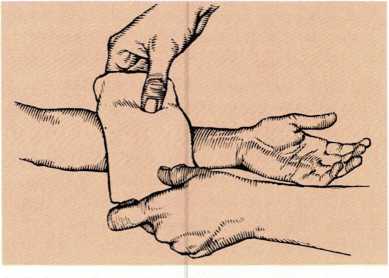
1. Fold a piece of cloth into a pad and place it on the bleeding
wound.

2. Then, press the cloth pad firmly against the bleeding wound.
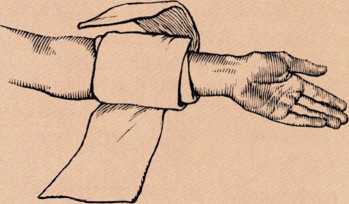
- Wrap a strip of cloth around the pad and the injured part of the
body.
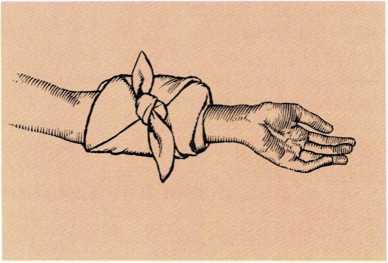
- Tie the cloth strip to hold the pad in place over the wound.
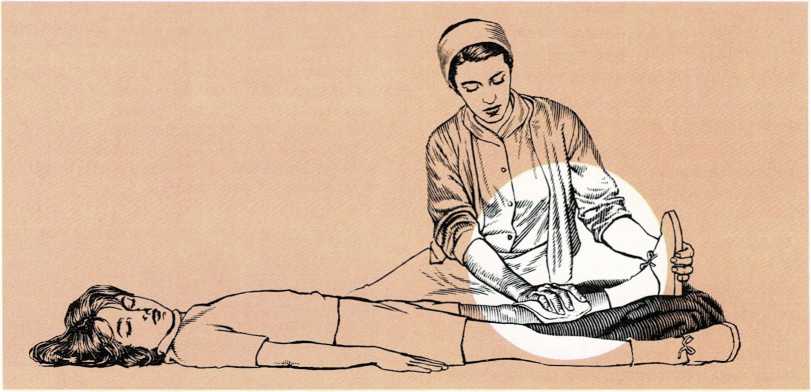
You can stop bleeding from a limb more quickly if you have the child
lie down. Next, elevate the limb by placing a pillow, a folded coat, a
folded blanket, or some other object under the injured limb.
Then place a folded cloth pad over the wound and apply direct
pressure.
If your child injures a large blood vessel, the blood clotting process
cannot form a plug. Severe bleeding results. To stop the bleeding, apply
direct pressure to the wound. Fold a towel or handkerchief into a pad,
and hold it on the wound. If you cannot find a cloth quickly, apply
pressure with your hand. If the bleeding persists, take the child
immediately to a hospital.
Sometimes blood clotting occurs in blood vessels that have not been
injured physically. This clotting is called thrombosis. Thrombosis
blocks blood vessels and reduces the flow of blood. The reduction of
blood flow to a vital organ can result in permanent injury to the organ.
Unusual bleeding—for example, bleeding without injury, excessive
bleeding from a slight injury, or bleeding that will not clot— occurs
for a variety of reasons. A child may have excessively fragile or
diseased blood vessels, not enough platelets or defective platelets, or
plasma that may lack clotting factors. The lack of clotting factors is
known as hemophilia, r.o.
See also Bleeding; Blood count; Hemophilia: Nosebleed
Blood count is an actual count of the cells in a precisely measured
drop of blood. The blood sample can be taken from one of the child’s
fingers or an earlobe, or from a blood vessel. The count is done by
examining the drop of blood under a microscope or by a machine. Blood
contains many different cells that perform specific jobs in the body.
The most important cells are the red cells, the white cells, and the
platelets. Healthy blood contains these cells in certain proportions.
Red cells get their bright coloring from hemoglobin, which contains
iron. Hemoglobin absorbs oxygen from the lungs and carries it to the
body tissues. White cells attack germs to prevent infection. Platelets,
which look like tiny disks, assist in blood clotting.
A blood count can give a doctor vital information. For instance, a low
count of red blood cells may show that a child has anemia. An increase
in white blood cells may indicate an infection. A normal blood count is
one sign of good health, r.o.
See also Anemia; Blood clotting; Blood type
Blood poisoning is an infection of the bloodstream caused by
microbes such as bacteria, fungi, and protozoa. Although microbes may
enter the bloodstream directly at the time of an injury, they usually
get into the blood by way of an infection that already exists in the
body—for example, appendicitis, pneumonia, a boil or a pimple, a sore
throat or tonsillitis, or an infected tooth.
A child with blood poisoning may have chills and fever, and may complain
of an aching body and feeling of weakness. The child’s skin may show a
rash, and the lymph glands in the armpits or groin may become tender.
This is an emergency. Call your doctor immediately, or take the child to
the nearest hospital, where antibiotics can be administered to fight the
infection.
Blood poisoning occurs more frequently in babies than in older children
because babies seem less able to keep infections from spreading. In rare
instances, a child’s body cannot produce the antibodies needed to
protect against infection, and the child has bloodstream infections
repeatedly, [h.d.r.. jr.]
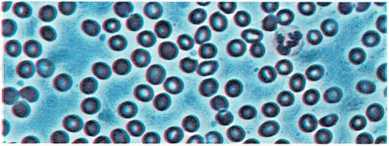
This blood sample is magnified and stained for examination. It is
taken from a child who has a normal blood count. The red blood cells are
doughnut shaped. The large cell in the upper right corner is a white
blood cell. A normal blood count is one sign of good health.
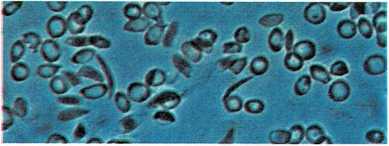
This magnified, stained blood sample is from a child with sickle
cell anemia—a hereditary, permanent anemia. In this type of anemia,
from 50 to 90 per cent of the red blood cells are shaped like
sickles.
Blood type. Everyone’s blood contains inherited chemical substances
known as “blood factors.” Combinations of these factors determine a
person’s blood type. You should know your children’s blood type.
One type of blood is just as healthy as another. But if a blood
transfusion is necessary, it is important to know that the blood of
patient and donor will mix without serious reaction. If they do not mix,
certain combinations of factors may cause red blood cells to clump
together. This clumping blocks small blood vessels and can cause serious
illness or even death. Blood typing makes safe transfusion possible by
ensuring that the blood of donor and patient will blend.
There are four major human blood groups —A, B, AB, and 0—and many
subdivisions. Blood is further classified as Rh-posi- tive and
Rh-negative. r.o
See also Rh factor
Blue baby. See Cyanosis
